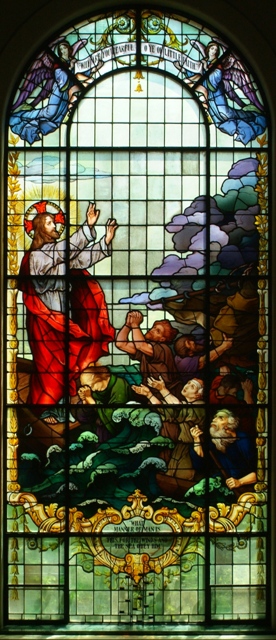
Jesus calms the seas
Jesus calms the seas in another window dedicated to his ministry. The Evangelists tell us that crossing the sea from Galilee to the country of Gerasens after the Sermon on the Mount, Jesus and his disciples encountered a violent storm upon the water. Fearing for their lives, the apostles quickly woke the sleeping Lord and asked that he spare their lives. Jesus rebuked them with the quote at the top of the window, “Why are you fearful O ye of little faith.” (Matt. 8: 26) In response to his followers’ pleas Jesus rises and commands the winds and the sea to be calm. Immediately the winds die down and the waves cease rolling. The apostles wonder, “What manner of man is this, for the winds and the sea obey him,” which is written at the bottom of the window. (Matt. 8: 27)
The window collapses the entire Gospel passage into a single dramatic moment full of human emotion and natural affect. In it, a terrible storm threatens to capsize the small boat that transports Jesus and his companions to Gerasens. The high, frothy waves, dark churning clouds and fast moving wind inform us that the storm is particularly ferocious. Frightened by their predicament, two apostles beseech the Lord to save them with raised hands and fearful expressions. Meanwhile, three others heroically battle the tempest. The action of the man at the mast is unclear; he is either trying to lower the sail or right the mast. At the stern two disciples row with all their might against the turbulent waves that lash against the tiny boat. The oarsman in the foreground is St Peter, identifiable by the convention of white hair and beard. St. John, indicated by his halo, alone resorts to prayer; he bows his head and clasps his hands before him. In response to his followers’ petitions, Jesus, in the boat’s prow, commands the storm to cease with raised hands. Immediately a cluster of dark, churning clouds moves away, leaving a placid blue sky. The golden rays emanating from Jesus’ halo give the appearance of sunshine, manifesting that Jesus is the Light of the World and revealing God’s power over creation.
The disciples’ failure to believe fully in the Lord is one of the window’s messages. Jesus’ rebuke of his followers, inscribed at the top of the window, expresses this theme. The artist’s depiction of the event also implies it. The Gospel passage is vague about the men’s initial response to the storm. From it we learn that the men feared for their lives upon encountering a tempest at sea. Did the men’s concerns arise while the storm was far off? Or only after they failed to navigate safely through it? And at what point did they awaken Jesus? The window suggests that the men responded variously: some deployed nautical skills, while others turned to spiritual ones. The rendering of the disciples as attempting to deal with the storm with human means when in the presence of the Lord underscores their lack of faith. The artist makes visible their unbelief by showing them surrounded by darkness and with their backs to Jesus. Their reliance on human ingenuity is emphasized in their turning to oars when the sail was of no use. St. Peter especially lacks faith, for though he witnesses the miracle before him, he continues to row!
The actions of the other three disciples however proclaim the importance of faith. As they raise their hands in supplication to the Lord, Jesus raises his own and quells the storm. Thus, turning to Jesus and asking for help, the men are spared from death. The men’s firm belief in the Lord is made visibly apparent in their failure to notice the abatement of the storm; even as the dark clouds move off, they either keep their eyes fixed firmly upon Jesus or bow their heads in prayer to him (St. John).
The most important message of the window, as of the Gospel account, is that Jesus truly is the Son of God. Throughout his teaching Jesus proclaims to be God’s own Son sent to reveal the Father’s will. But words are not enough to convince the people of Israel; they require “mighty works and wonders and signs”. And what better way is there for Jesus to prove his point than to control the heavens and sea made by the Father in the first days of creation? Designing this image, the artist might have drawn upon the medieval pictorial tradition for God creating the world found at the start of Bibles. In a series of images depicting the first days, God, shown as the Son, brings forth by means of a simple hand gesture the various elements and creatures of the earth, which in turn appear in the sphere he holds in his other hand. The window of Jesus calming the seas does more than visualize a past event; it invites us today to turn to the Lord, especially in times of trouble. The image reminds us through mere paint and glass of the awesome power of God, as it warns us of the limited nature of humankind. Moreover, implied in the juxtaposition of believing and unbelieving apostles is the question, “Which part of the boat do you inhabit?”